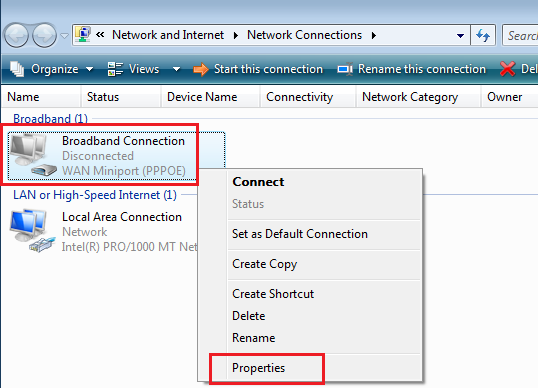
Do you have a DSL or Cable broadband connection that requires you to install special software in order to access the Internet? There's a good chance that you don't need this software. Windows XP comes with the ability to create PPPoE (Point-to-Point Protocol over Ethernet) connections.
PPPoE is technology used by ISPs to manage customer's accounts and access from your computer to the Internet.
Setting up the PPPoE connection Now select Set up a new connection or network. Select Connect to the internet then click Next. Then select Broadband (PPPoE). PPPoE Router and Modem Configuration The steps to set up a router for this protocol vary depending on the device model. In the Setup or Internet menus, select PPPoE as the connection type and enter the required parameters in the fields provided. You need to know the PPPoE username, password, and (sometimes) Maximum Transmission Unit size.
- Is it possible to start pppoe connection automatically when the system boots into vista ultimate? Any help would be appreciated. Thanks for your time.
- The best way to use PPPoE on Linux is to do it with the help of pppd (Point-to-Point Protocol daemon) package, which supports PPPoE since version 2.4.2, and is usually pre-installed (in case it’s not, you can easily get and install it). PPPD is used to manage network connections between two nodes on Unix-like operating systems.
- To create a PPPoE connection: Open the Control Panel folder from the Start menu. Double click the 'Network Connections' folder. Click the link in the Network Tasks pane that says 'Create a new connection'. In the first page of the 'Network Connection Wizard', press the Next button. Click 'Connect to the Internet', and then press the Next button.
To create a PPPoE connection:
- Open the Control Panel folder from the Start menu.
- Double click the 'Network Connections' folder.
- Click the link in the Network Tasks pane that says 'Create a new connection'.
- In the first page of the 'Network Connection Wizard', press the Next button.
- Click 'Connect to the Internet', and then press the Next button.
- Click 'Set up my connection manually', and then press the Next button.
- Click 'Connect using a broadband connection that requires a user name and password' (if your ISP provided you a user name and password select this option) or 'Connect using a broadband connection that is always on'. You selection depends on your connection type, contact your ISP if you have questions.
- Enter your ISP name into the field, and then press the Next button.
- If required, enter your user name and password provided to you by your ISP, and then press the Next button.
- Optionally you can click 'Add a shortcut to this connection to my desktop'. Press the Finish button when done.
Broadband access and Next Generation Networks (NGN) conception became part of everyday life. According to Parks Associates the number of households worldwide with broadband is approaching to 500 million and it may reach close to 650 million by 2013. The demand for speed of data transferring always increases, just as the amount of users who are connected by means Ethernet, which allows them to connect to the network with the speed up to 10Gb/sec.
Internet Service Providers (ISP) that provide users with Ethernet-channel generally use the following technologies for user authentication and billing:
- User account binding to the physical line, for example, using MAC-address of the network interface. Linux user has to configure network interfaces to establish such a connection;
- VPN-technologies allowing user authentication and secure connection. For example, PPTP, L2TP or IpSec;
- PPPoE (Point-to-Point Protocol over Ethernet) which this article is about.

PPPoE represents a network protocol for encapsulating Point-to-Point Protocol (PPP) frames inside Ethernet frames. PPPoE expands the capability of PPP allowing a virtual Point-to-Point connection over a multipoint Ethernet network architecture. Given protocol was published by IETF in 1999 and its specification is RFC 2516.
In fact PPPoE does not have important advantages in comparison to the above mentioned alternatives. However the following ones can be emphasized:
- It’s significantly more secure than MAC-binding and allows user to change network interfaces connected to the provider without appealing to provider’s customer support; still it slightly reduces the bandwidth of the network interface;
- Its configuration is simpler that the one of VPN-connection and requires less parameters to be introduced by user. In particular there is no need to configure IP-address or to specify the address of VPN-server.
Thus, most likely you will encounter PPPoE just because you ISP will provide the Internet via this technology. Although provider’s technical support generally can help you just with Windows, you can easily connect your PC with Linux operating system following our instructions.
The best way to use PPPoE on Linux is to do it with the help of pppd (Point-to-Point Protocol daemon) package, which supports PPPoE since version 2.4.2, and is usually pre-installed (in case it’s not, you can easily get and install it). PPPD is used to manage network connections between two nodes on Unix-like operating systems. The role of pppd is to manage PPP session establishment and session termination.
In addition to that there must be in-kernel PPPoE support. Most likely you already have it because it’s included in all modern distributions by default. However if you don’t, we will discuss how to add it a little bit later.
For now let’s see how you can set up a PPPoE connection using graphical interface (in this certain case we will use Ubuntu 9.04, though Ubuntu 9.10 beta is already available). Open: System – Preferences – Network Connection. Choose DSL tab and press “Add”:
Fill in the “Connection name” (anything you want), “Username” and “Password” fields, check or leave uncheck “Connect automatically”, “Show password” and “Available to all users” boxes:
NOTE: In case you are going to use this connection just for the Internet, you can leave “Service” field empty.
Choose Ipv4 Settings tab and make sure that the Method is Automatic (PPPoE):
That’s it! Now you can connect to the Internet without any problems.
However if you don’t really like using graphical interface or simply haven’t it (for example, on the server), there is another way to configure it.
First of all you need to check if there is in-kernel PPPoE support:
modprobe pppoe
In case the module wasn’t found, we need to create a kernel module. Make sure that you have kernel sources by going to the source directory – /usr/src/linux-x.x.x and run the following command:
make menuconfig
In the configuration window that will appear after the previous command open Network device support -> PPP over Ethernet (Experimental) and set “M” value there;
Or you can directly change .config (that can be found in the source directory – /usr/src/linux-x.x.x/):
CONFIG_PPPOE=m
Now we need to compile modules:
make modules
In case you get some compile errors like “field pppox have not defined in union…”, just as I did, try to make some changes in the following two files:
/usr/src/linux-x.x.x/drivers/net/pppoe.c
/usr/src/linux-x.x.x/drivers/net/pppox.c
– Add just after the comments (before any of #include directives) the following line:
#define CONFIG_PPPOE_MODULE
– Save the above mentioned files and retry compiling with
make modules
Creating A Pppoe Connection In Vista Florida
After successful compiling copy files
/usr/src/linux-x.x.x/drivers/net/pppoe.o
/usr/src/linux-x.x.x/drivers/net/pppox.o
(pay attention to “.o” extention!) to /lib/modules/x.x.x/kernel/drivers/net
Refresh the file with dependencies:
depmod -a
Now check one more time if the following command is working:
modprobe pppoe
In case it’s ok, we can go ahead with pppd configuration.
1) We need to add to /etc/ppp/chap-secrets our login and password.
If you plan to use pppd for more than one connection, than there is a necessity to introduce a unique ID along with login and password. For example, “PROV”:
ourlogin PROV ourpassword *
(of course, instead of “ourlogin” and “ourpassword” we need to write true values)
2) We have to create a file (let it be “myprov”) in /etc/ppp/peers.
Here are the things we need to write in this file:
user ourlogin (ourlogin – the same login as we introduced in chap-secrets)
plugin rp-pppoe.so
eth0 (your interface via which you want to receive pppoe)
noipdefault (in case your ISP provides dynamic IP)
usepeerdns (to receive DNS from provider)
defaultroute (while connecting to the Internet the provider’s router will be used as a gateway by default)
persist (fixed connection)
remotename PROV (PROV – an ID we introduced in chap-secrets)
Creating A Pppoe Connection In Vista Catalina
3) Finally we need to save everything. Carousel star responsive carousel slider banner. To call the connection we use the command:
pppd call myprov
If pppd displays that it can’t load, for example, /usr/lib/pppd/2.4.3/rp-pppoe.so, we need to check where pppd is:
whereis pppd
– After that we should make a link in /usr/lib/pppd/2.4.3 to our rp-pppoe.so:
ln –s [our rp-pppoe.so] [/usr/lib/pppd/2.4.3/rp-pppoe.so]
If pppd loads, but fails to create PPPoE socket, check log, maybe there are some messages like:
modprobe: can’t locate module net-pf-24
– If there are, we need to write in /etc/modules.conf:
alias net-pf-24 pppoe
No doubt using PPPoE in Linux is as simple as it is in other operating systems. Graphical interface allows you to connect it in a very fast and intuitive way. However if you want be able to solve different kind of problems that may appear, it’s a great idea to make use of command line. Anyway it won’t take you more than 5-10 minutes to setup the connection, so check it out right now in order to see how easy it is.

